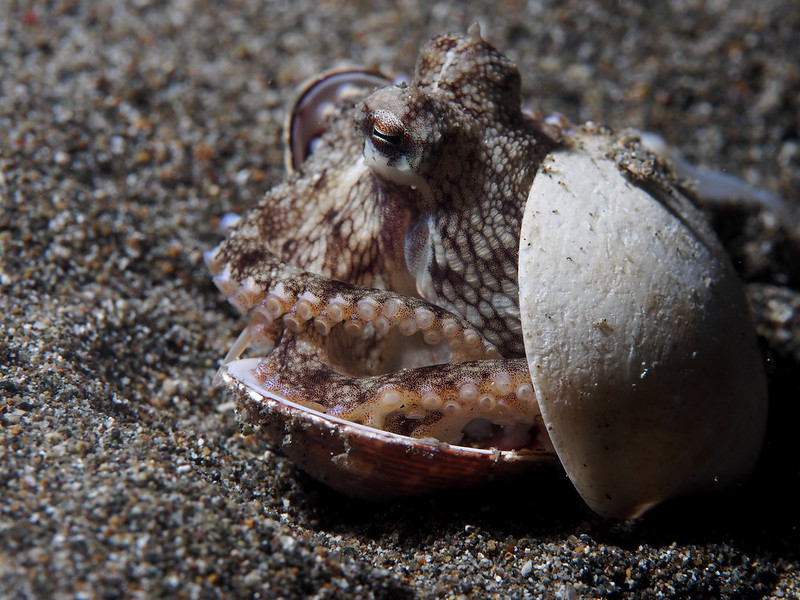Coconut Octopus Facts
- For understandable reasons, this mesmerizing denizen of the depths most frequently goes by the informative common name of the Coconut Octopus. It does, however, hold yet another common name. That’s the alternate term of the veined octopus.
- Professionals, such as researchers, use another term whe referring to the creatue. That’s its formal scientific name. That term, though, remains somewhat hard to pronounce for most of us. That’s because it’s known to scientists as the Amphioctopus marginatus.
- Regardless of the name one uses to speak of it though, it represents a fabulous work of evolution. This fascinating marvel of Nature’s also relatively new to the halls of science. That’s due to the fact that the discovery of this unique species only occurred in 1964.
- The first recognition of it as a separate and distinct species therefore took place at that time. The respected Japanese malacologist, Iwao Taki, holds the distinction of being the first to acknowledge its individuality as a species. He also discovered many others.
- For the moment, thankfully, it appears to be maintaining a population base that’s both stable and sufficient. This further seems to hold true throughout the entirety of its natural range. The IUCN, therefore, presently lists it as Least Concern on its Red List.
- The Coconut Octopus nevertheless must be considered to be at some risk, like other species. Due to the nature of its habitat, loss or modification of that remains a danger. Its greatest threat, however, most likely consists of the effects of climate change.
Related Articles
Flapjack Octopus
Coconut Octopus Physical Description
The miracle of Nature and evolution we call the Coconut Octopus clearly impresses those who encounter it. While it does so for various reasons, sheer size isn’t counted among them. That’s because, compared to many of its brethren, it’s a very small species of octopus.
Unlike many of its related species, however, it does not display any notable degree of the physiological characteristic of sexual dimorphism. Due to that fact, individuals of both genders remain virtually indistiguishable to the naked eye, including in terms of size.
It further represents one of the smallest of all known cephalopods. More specifically, mature specimens of both sexes attain an overall body length measuring roughly 3.1 in (8 cm). The extended tentacles, though, increase that length to approximately 6 in (15.2 cm).
While its colors vary at will, as others of its kind, certain patterns nevertheless predominate. As a general principle, individuals manifest a lighter background, with numerous thin, darker lines. Said by some to resemble veins, these serve as the source of one common name.
The arms of the Coconut Octopus, meanwhile, display a different pattern of colors. These typically display a darker shade. Contrasting that, though, the suckers usually present a bright white shade. It also oftens manifests a light trapezoidal area under each eye.
- Kingdom: Animalia
- Phylum: Mollusca
- Class: Cephalopoda
- Order: Octopoda
- Family: Octopodidae
- Genus: Amphioctopus
- Species: A. marginatus
Coconut Octopus Distribution, Habitat, and Ecology
Unfortunately, the remarkable Coconut Octopus appears to inhabit a somewhat restricted zone of habitation. That holds true due to the fact that, for the moment, its only known area of habitation consists of sections of the western Pacific Ocean and Indian Ocean.
More specifically, though, it only seems to live in the tropical sections of this already limited range. That zone of habitation includes the waters of Australia. From there, it also appears in the ocean near South Africa, southern Japan, New Guinea, Indonesia, and India.
Researchers still know precious little about this magnificent creature, but some facts present themselves. In all areas it appears, it displays a strong preference for a benthic habitat. The vast majority of observed individuals live at depths of around 600 ft (183 m).
It further displays a strong preference for certain types of conditions. Most monitored specimens made their home in areas consisting of either muddy or sandy surfaces. Most commonly, these areas of habitation consist of various local lagoons and bays.
Evidence further indicates that the marvelous Coconut Octopus lives a solitary existence, rarely interacting with others of their kind. The majority of its time appears to be spent buried in the sand, either watching for prey, or avoiding its own natural predators.
It’s also developed a highly unique and scientifically fascinating shared behavioral trait. This trait, in fact, serves as the source of the most popular common name. That’s because individuals often seek out, and actively use, the shells of coconuts for shelter!
When it feeds, this highly intelligent predator represents an efficient carnivore. It typically feeds on smaller prey, given its own size, of course. These most frequently include such creatures as shrimp, small fish, and various crustaceans they uncover with their tentacles.
Species Sharing Its Range
Check out our other articles on 3 Clearly Captivating Corals, Yellow Throated Marten, Carbet Falls, New Zealand Giraffe Weevil, African Tulip Tree, Saltwater Crocodile, Hyacinth Macaw

